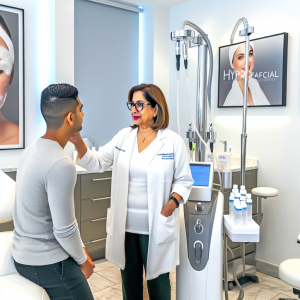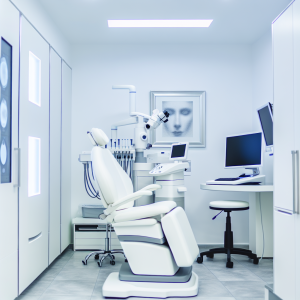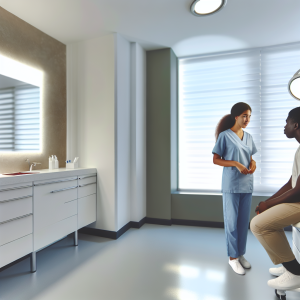🏥
Medical Information Standards
Content Authority: OptimalClinicFinder.com is a comprehensive medical directory platform connecting patients with qualified Acne Scar Treatment providers. Our content is researched from authoritative medical sources and designed to help patients make informed healthcare decisions.
How Professional Acne Scar Treatment Works: Clinical Mechanisms and Applications
Professional acne scar treatments work through controlled tissue remodeling, stimulating the body’s natural healing response to rebuild damaged skin architecture. The most effective treatments target the dermis, where collagen and elastin fibers provide skin structure and elasticity. Laser resurfacing uses focused light energy to create microscopic treatment zones, triggering controlled wound healing that replaces scarred tissue with new, healthy collagen.
Microneedling procedures create thousands of tiny punctures in the skin, activating fibroblast cells that produce new collagen and elastin. This process, called neocollagenesis, gradually fills in depressed scars and improves overall skin texture. Chemical peels work through controlled exfoliation, removing damaged surface layers while stimulating deeper cellular renewal. The depth and intensity of treatment can be customized based on scar type, skin condition, and patient goals.
💡
Did You Know?
Clinical studies show that Acne Scar Treatment patients achieve excellent results when combined with professional-grade aftercare products.
Clinical Research and Evidence Base
Extensive clinical research supports the effectiveness of professional acne scar treatments, with multiple randomized controlled trials demonstrating significant improvement in scar appearance and patient satisfaction. Fractional laser studies show 50-75% improvement in scar depth and texture after 3-5 treatment sessions. Microneedling research indicates 60-90% patient satisfaction rates with visible improvement in rolling and boxcar scars.
Comparative studies reveal that combination therapies often produce superior results compared to single-modality treatments. Research involving over 2,000 patients across diverse skin types confirms safety and efficacy across different ethnicities and age groups. Long-term follow-up studies demonstrate durability of results, with maintained improvement documented up to 5 years post-treatment. Meta-analyses consistently rank professional treatments significantly more effective than over-the-counter options for moderate to severe acne scarring.
Treatment Protocols and Clinical Management
Successful acne scar treatment begins with comprehensive skin assessment and customized treatment planning. The evaluation process includes scar classification (ice pick, rolling, boxcar, or hypertrophic), skin type assessment, and medical history review. Providers must assess realistic expectations, timeline preferences, and budget considerations to develop optimal treatment protocols.
Standard protocols typically involve series treatments spaced 4-8 weeks apart to allow complete healing between sessions. Most patients require 3-6 sessions for optimal results, though severe scarring may require additional treatments. Pre-treatment preparation includes sun avoidance, discontinuation of certain medications, and topical preparation protocols. Post-treatment care involves specific wound care instructions, sun protection, and follow-up monitoring to ensure proper healing and optimal results.
💡
Quick Tip
Acne Scar Treatment works best when combined with healthy lifestyle choices for optimal results.
Safety Profile and Risk Management
Professional acne scar treatments demonstrate excellent safety profiles when performed by qualified practitioners using appropriate protocols. Common temporary side effects include redness, swelling, and mild discomfort lasting 3-7 days post-treatment. These effects are expected parts of the healing process and typically resolve without intervention.
Rare complications may include temporary hyperpigmentation (5-10% incidence), prolonged erythema (2-5% incidence), or infection (less than 1% incidence). Risk factors for complications include active skin conditions, certain medications, recent sun exposure, and unrealistic treatment depth expectations. Proper patient selection, appropriate treatment parameters, and comprehensive aftercare minimize complication risks and optimize treatment outcomes.
Acne Scar Treatment Near Me: Cost Analysis and Financial Considerations
The investment in professional acne scar treatment varies based on treatment type, geographic location, provider expertise, and treatment complexity. Fractional laser treatments typically cost $600-$1,500 per session, while microneedling ranges from $200-$600 per session. Chemical peels cost $150-$500 per treatment, and dermal filler treatments range from $400-$800 per session.
Most patients require series treatments, making total investment $1,500-$6,000 for complete treatment courses. While insurance typically doesn’t cover cosmetic acne scar treatment, many providers offer financing options and treatment packages that reduce per-session costs. When evaluating cost, consider the long-term value of professional treatment compared to ongoing expenses for ineffective over-the-counter products.
Provider Selection and Treatment Access
Selecting qualified providers is crucial for safe, effective acne scar treatment outcomes. Board-certified dermatologists and plastic surgeons possess specialized training in skin anatomy, wound healing, and aesthetic procedures. Look for providers with specific acne scar treatment experience, current technology, and comprehensive approach to patient care.
✓
Why Choose Acne Scar Treatment?
●
Clinically proven
●
FDA approved
●
Minimal downtime
●
Long-lasting
Research potential providers by reviewing credentials, before-and-after photos, patient testimonials, and consultation approaches. Quality providers conduct thorough consultations, explain treatment options clearly, provide realistic expectations, and prioritize patient safety. Avoid providers offering unrealistic promises, unusually low prices, or high-pressure sales tactics, as these may indicate inadequate training or inappropriate treatment protocols.
Geographic Availability and Access Options
Access to professional acne scar treatment has expanded significantly, with qualified providers available in most metropolitan areas. Larger cities typically offer more treatment options and competitive pricing, while smaller markets may have limited provider choices but potentially more personalized care. Medical tourism options exist for patients in underserved areas, though local follow-up care considerations are important.
Many providers now offer virtual consultations for initial evaluations, though in-person assessment remains necessary for treatment planning and procedure performance. Some practices provide travel packages for out-of-area patients, including accommodation recommendations and extended follow-up care protocols.
Treatment Timeline and Expectations
Professional acne scar treatment requires patience and realistic expectations for optimal satisfaction. Initial improvement typically becomes visible 4-6 weeks after first treatment, with progressive enhancement over subsequent months as collagen remodeling continues. Peak results usually develop 3-6 months after completing treatment series.
Maintenance treatments may be recommended annually or bi-annually to sustain results and address new concerns. Some patients choose to combine multiple treatment modalities or add adjunctive therapies like platelet-rich plasma (PRP) or growth factors to enhance outcomes. Long-term skin care routines, including professional-grade products and sun protection, help maintain treatment benefits and prevent new damage.
📚 Medical Authorities & Professional Standards
All Acne Scar Treatment procedures should be performed by licensed medical professionals following established clinical guidelines and safety protocols.
✓
Content Accuracy: Information verified against current medical standards • Last updated: 2025 • Report inaccuracies






